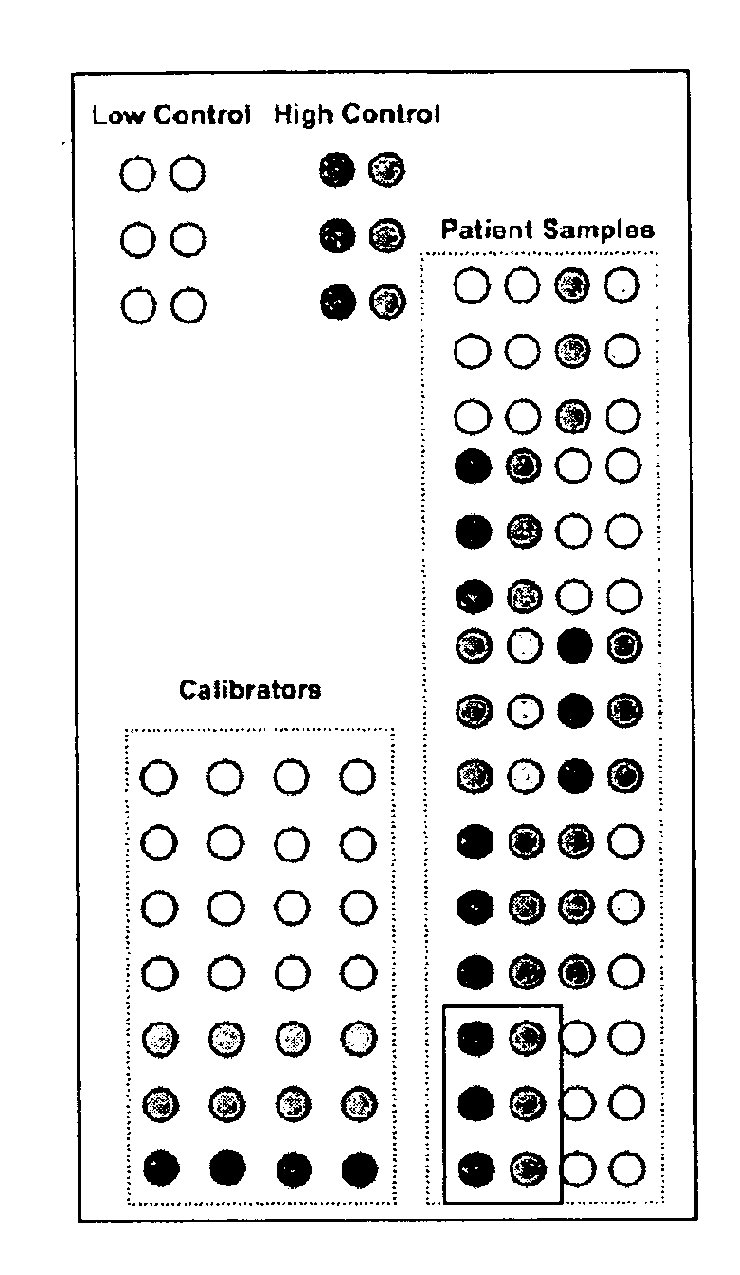Calibrated rpma assay
a colorimetric system and rpma technology, applied in material analysis, instruments, measurement devices, etc., can solve problems such as poor colorimetric system dynamic rang
- Summary
- Abstract
- Description
- Claims
- Application Information
AI Technical Summary
Problems solved by technology
Method used
Image
Examples
example i
Materials and Methods
[0096]Methods for preparing, assaying, and analyzing samples for a method of the invention are conventional and well-known to skilled workers. Some of these methods are described below:
Laser Capture Microdissection (of tumor cells): 8 um frozen sections are prepared on either glass or membrane slides. Frozen sections are fixed in 70% ethanol, stained with Mayer's Hematoxylin and Scott's Tap Water Substitute, and dehydrated in gradient ethanol, with a final clearing in xylene.
[0097]The slides are rapidly air dried and tumor cells are isolated by laser capture microdissection (Pixcell™ and Veritas™, Arcturus Molecular Devices; CA, USA). Formalin or alcohol fixed paraffin embedded specimens can also be used, and subjected to Laser Capture Microdissection as above with appropriate tissue stains.
Reverse Phase Protein Microarrays. Microdissected cells are subjected to lysis in boiling 2.5% beta-mercaptoethanol in T-PER (Pierce, Rockford, Ill.) mixed 1:1 with 2×SDS Tri...
example ii
An Illustrative Assay of 26 Analytes
[0098]In the present Example, tissue samples from 2 to about 500 patients are prepared and lysed, and aliquots of the whole cell lysates are printed onto slides in a microarray, as described in Example I. Each lysate is printed as a neat and as a 1:4 dilution, each in triplicate. The lysates are printed onto each of 27 slides, each one for the determination of a different analyte in the sample, as well as one slide that is stained for total protein (e.g Sypro Ruby Blot Stain, Molecular Probes Eugene, Oreg.). The analytes to be analyzed / quantitated are:
1. Total EGFR
[0099]2. Total c-erbB2
3. Total VEGFR2 (KDR, Flk-2)
4. Total PDGFRbeta
5. Total PDGFRalpha
6. Total FLT3
7. Phospho FLT-3 (Y5899 / Y591)
8. Phospho VEGFR2 (Y1212)
9. Phospho VEGFR1 (Y1213)
[0100]10. Phospho PDGFR beta (Y751) / Y735)
11. Phospho PDGFR alpha (Y754)
12. Phospho RET (Y905)
13. Phospho Src (Y416)
14. Phospho AKT (S473)
15. Phospho Shc (Y317)
16. Phospho Ckit (Y719)
[0101]17. Phospho cabl (Y735)...
example iii
Quantitative Analysis of the Total Amount of an Unmodified Protein, c-erbB2
[0113]Whole cell lysates of tissue samples from patients having metastatic breast cancer are analyzed as above, except a single set of calibrants is used. To prepare the set of calibrants,
a) A lysate is prepared of SKBR-3 cells (known to have approx 2,390,000±130,000 c-erbB2 receptors / cell, corresponding to a 3+ immunohistochemical score). This is the “upper” calibrant.
b) A lysate is prepared of MDA231 cells (known to have approx 21,600±6700 c-erbB2 receptors / cell, corresponding to a 0 immunohistochemical score). This is the “lower” calibrant.
c) The volumes of either a) or b) are adjusted such that the total amount of protein in each of these calibrants is equivalent.
d) The contents of a) and b) are mixed into predefined, predictable series of dilutions such that the values of c-erbB2 range from the SKBR-3 (upper) value to the MDA 231 (lower) value.
PUM
| Property | Measurement | Unit |
|---|---|---|
| Concentration | aaaaa | aaaaa |
| Biological properties | aaaaa | aaaaa |
| Order | aaaaa | aaaaa |
Abstract
Description
Claims
Application Information
 Login to View More
Login to View More - R&D
- Intellectual Property
- Life Sciences
- Materials
- Tech Scout
- Unparalleled Data Quality
- Higher Quality Content
- 60% Fewer Hallucinations
Browse by: Latest US Patents, China's latest patents, Technical Efficacy Thesaurus, Application Domain, Technology Topic, Popular Technical Reports.
© 2025 PatSnap. All rights reserved.Legal|Privacy policy|Modern Slavery Act Transparency Statement|Sitemap|About US| Contact US: help@patsnap.com


